Financial Reporting: Accounting Principles, Case Study, and Project
VerifiedAdded on 2023/06/03
|17
|3214
|446
Report
AI Summary
This report delves into the intricacies of financial reporting, commencing with an exploration of fundamental accounting principles such as double-entry bookkeeping and the use of general journals and ledgers. It then examines Goods and Services Tax (GST) regulations in Australia and presents detailed examples of journal entries and general ledger postings, culminating in a trial balance. The report further analyzes the balance sheet and revenue statements, including cost of goods sold, gross profit, and operating profit. A case study is presented, demonstrating the recording and depreciation of assets using the straight-line method, supported by asset register cards. Finally, the report incorporates project work, addressing the fixed asset register, depreciation methods, and the computation of depreciation, providing a comprehensive overview of financial reporting practices.

Running head: PREPARE FINANCIAL REPORTS
Prepare financial reports
Name of the student
Name of the university
Student ID
Author note
Prepare financial reports
Name of the student
Name of the university
Student ID
Author note
Paraphrase This Document
Need a fresh take? Get an instant paraphrase of this document with our AI Paraphraser
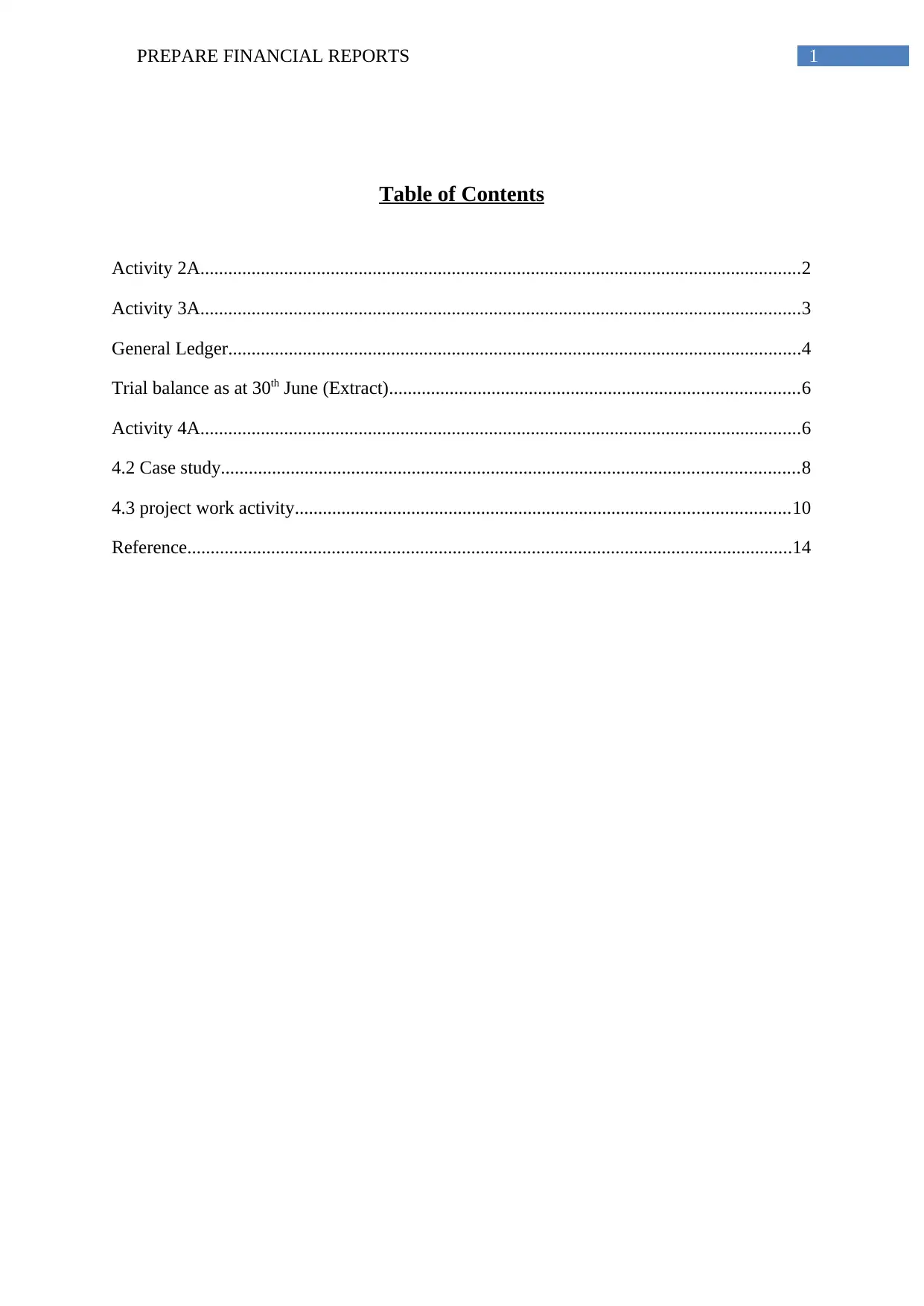
1PREPARE FINANCIAL REPORTS
Table of Contents
Activity 2A.................................................................................................................................2
Activity 3A.................................................................................................................................3
General Ledger...........................................................................................................................4
Trial balance as at 30th June (Extract)........................................................................................6
Activity 4A.................................................................................................................................6
4.2 Case study............................................................................................................................8
4.3 project work activity..........................................................................................................10
Reference..................................................................................................................................14
Table of Contents
Activity 2A.................................................................................................................................2
Activity 3A.................................................................................................................................3
General Ledger...........................................................................................................................4
Trial balance as at 30th June (Extract)........................................................................................6
Activity 4A.................................................................................................................................6
4.2 Case study............................................................................................................................8
4.3 project work activity..........................................................................................................10
Reference..................................................................................................................................14
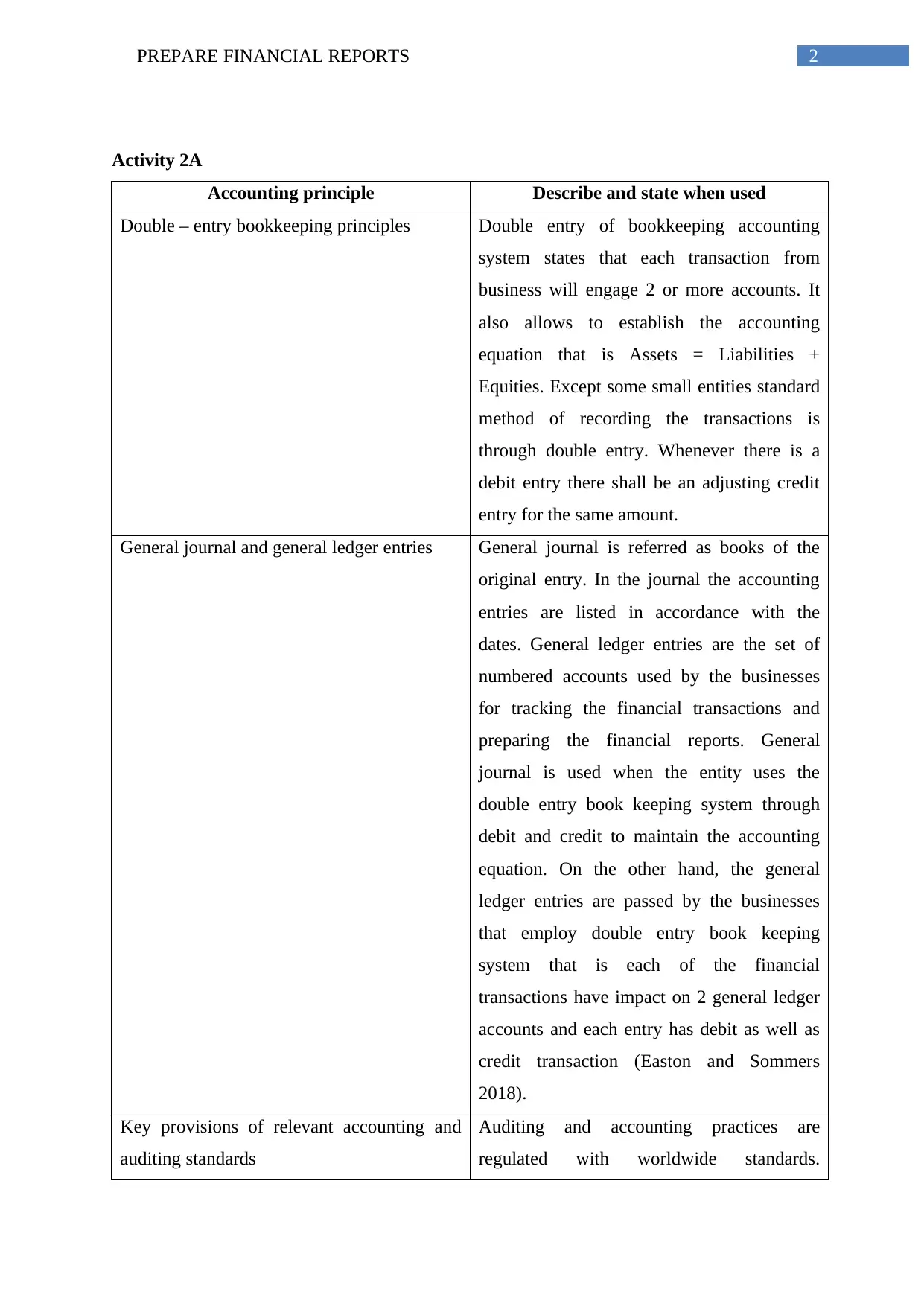
2PREPARE FINANCIAL REPORTS
Activity 2A
Accounting principle Describe and state when used
Double – entry bookkeeping principles Double entry of bookkeeping accounting
system states that each transaction from
business will engage 2 or more accounts. It
also allows to establish the accounting
equation that is Assets = Liabilities +
Equities. Except some small entities standard
method of recording the transactions is
through double entry. Whenever there is a
debit entry there shall be an adjusting credit
entry for the same amount.
General journal and general ledger entries General journal is referred as books of the
original entry. In the journal the accounting
entries are listed in accordance with the
dates. General ledger entries are the set of
numbered accounts used by the businesses
for tracking the financial transactions and
preparing the financial reports. General
journal is used when the entity uses the
double entry book keeping system through
debit and credit to maintain the accounting
equation. On the other hand, the general
ledger entries are passed by the businesses
that employ double entry book keeping
system that is each of the financial
transactions have impact on 2 general ledger
accounts and each entry has debit as well as
credit transaction (Easton and Sommers
2018).
Key provisions of relevant accounting and
auditing standards
Auditing and accounting practices are
regulated with worldwide standards.
Activity 2A
Accounting principle Describe and state when used
Double – entry bookkeeping principles Double entry of bookkeeping accounting
system states that each transaction from
business will engage 2 or more accounts. It
also allows to establish the accounting
equation that is Assets = Liabilities +
Equities. Except some small entities standard
method of recording the transactions is
through double entry. Whenever there is a
debit entry there shall be an adjusting credit
entry for the same amount.
General journal and general ledger entries General journal is referred as books of the
original entry. In the journal the accounting
entries are listed in accordance with the
dates. General ledger entries are the set of
numbered accounts used by the businesses
for tracking the financial transactions and
preparing the financial reports. General
journal is used when the entity uses the
double entry book keeping system through
debit and credit to maintain the accounting
equation. On the other hand, the general
ledger entries are passed by the businesses
that employ double entry book keeping
system that is each of the financial
transactions have impact on 2 general ledger
accounts and each entry has debit as well as
credit transaction (Easton and Sommers
2018).
Key provisions of relevant accounting and
auditing standards
Auditing and accounting practices are
regulated with worldwide standards.
⊘ This is a preview!⊘
Do you want full access?
Subscribe today to unlock all pages.

Trusted by 1+ million students worldwide
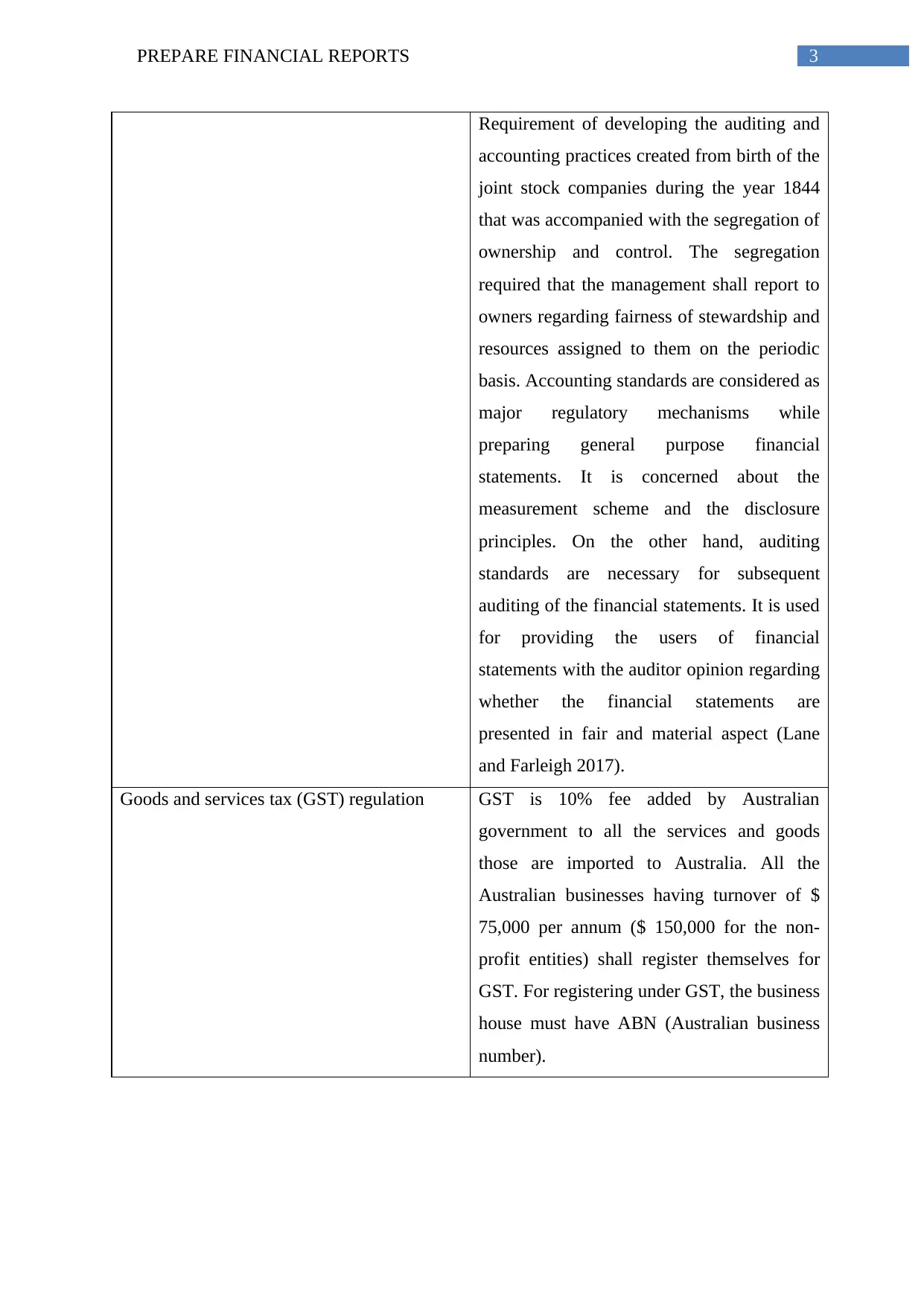
3PREPARE FINANCIAL REPORTS
Requirement of developing the auditing and
accounting practices created from birth of the
joint stock companies during the year 1844
that was accompanied with the segregation of
ownership and control. The segregation
required that the management shall report to
owners regarding fairness of stewardship and
resources assigned to them on the periodic
basis. Accounting standards are considered as
major regulatory mechanisms while
preparing general purpose financial
statements. It is concerned about the
measurement scheme and the disclosure
principles. On the other hand, auditing
standards are necessary for subsequent
auditing of the financial statements. It is used
for providing the users of financial
statements with the auditor opinion regarding
whether the financial statements are
presented in fair and material aspect (Lane
and Farleigh 2017).
Goods and services tax (GST) regulation GST is 10% fee added by Australian
government to all the services and goods
those are imported to Australia. All the
Australian businesses having turnover of $
75,000 per annum ($ 150,000 for the non-
profit entities) shall register themselves for
GST. For registering under GST, the business
house must have ABN (Australian business
number).
Requirement of developing the auditing and
accounting practices created from birth of the
joint stock companies during the year 1844
that was accompanied with the segregation of
ownership and control. The segregation
required that the management shall report to
owners regarding fairness of stewardship and
resources assigned to them on the periodic
basis. Accounting standards are considered as
major regulatory mechanisms while
preparing general purpose financial
statements. It is concerned about the
measurement scheme and the disclosure
principles. On the other hand, auditing
standards are necessary for subsequent
auditing of the financial statements. It is used
for providing the users of financial
statements with the auditor opinion regarding
whether the financial statements are
presented in fair and material aspect (Lane
and Farleigh 2017).
Goods and services tax (GST) regulation GST is 10% fee added by Australian
government to all the services and goods
those are imported to Australia. All the
Australian businesses having turnover of $
75,000 per annum ($ 150,000 for the non-
profit entities) shall register themselves for
GST. For registering under GST, the business
house must have ABN (Australian business
number).
Paraphrase This Document
Need a fresh take? Get an instant paraphrase of this document with our AI Paraphraser
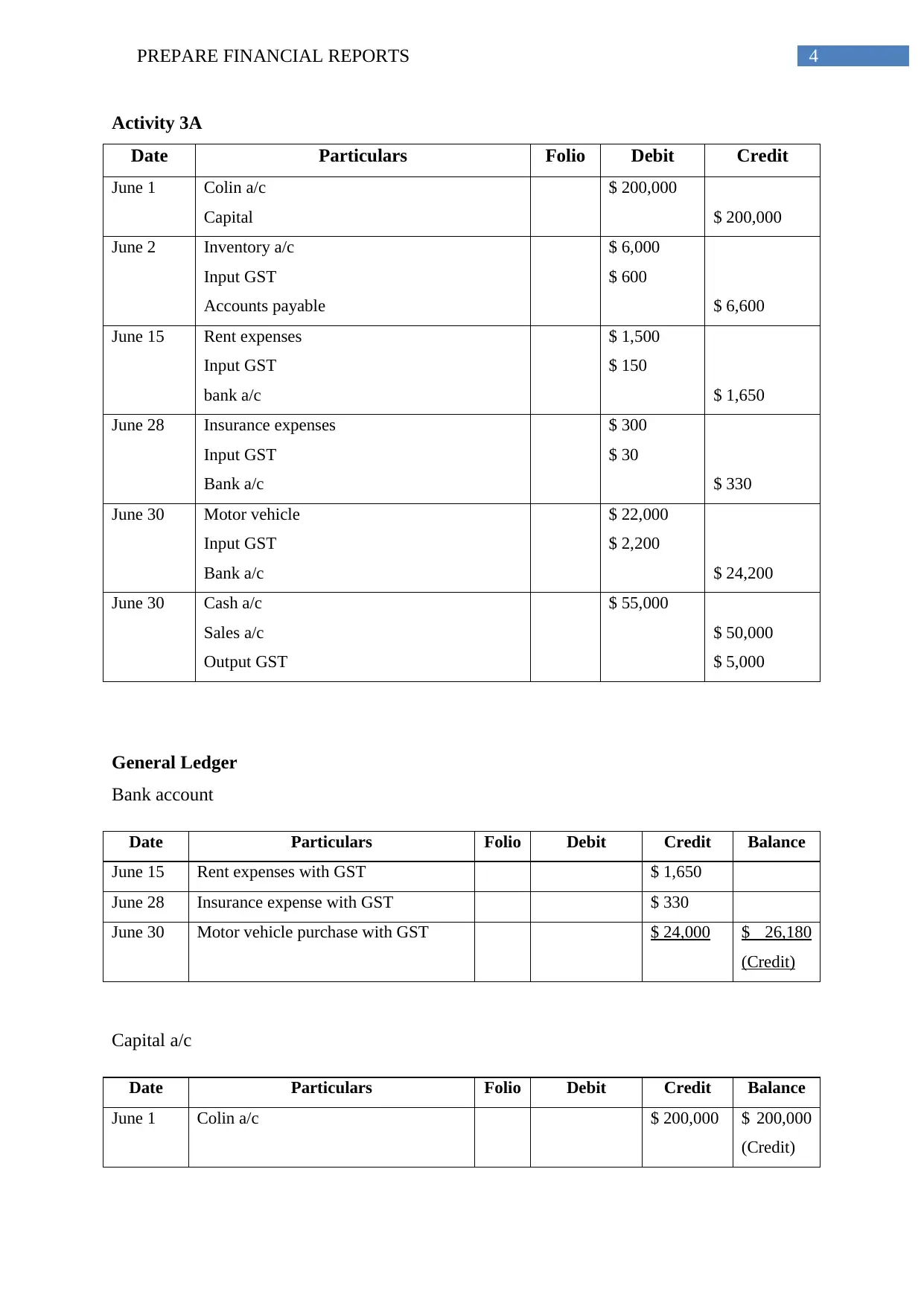
4PREPARE FINANCIAL REPORTS
Activity 3A
Date Particulars Folio Debit Credit
June 1 Colin a/c
Capital
$ 200,000
$ 200,000
June 2 Inventory a/c
Input GST
Accounts payable
$ 6,000
$ 600
$ 6,600
June 15 Rent expenses
Input GST
bank a/c
$ 1,500
$ 150
$ 1,650
June 28 Insurance expenses
Input GST
Bank a/c
$ 300
$ 30
$ 330
June 30 Motor vehicle
Input GST
Bank a/c
$ 22,000
$ 2,200
$ 24,200
June 30 Cash a/c
Sales a/c
Output GST
$ 55,000
$ 50,000
$ 5,000
General Ledger
Bank account
Date Particulars Folio Debit Credit Balance
June 15 Rent expenses with GST $ 1,650
June 28 Insurance expense with GST $ 330
June 30 Motor vehicle purchase with GST $ 24,000 $ 26,180
(Credit)
Capital a/c
Date Particulars Folio Debit Credit Balance
June 1 Colin a/c $ 200,000 $ 200,000
(Credit)
Activity 3A
Date Particulars Folio Debit Credit
June 1 Colin a/c
Capital
$ 200,000
$ 200,000
June 2 Inventory a/c
Input GST
Accounts payable
$ 6,000
$ 600
$ 6,600
June 15 Rent expenses
Input GST
bank a/c
$ 1,500
$ 150
$ 1,650
June 28 Insurance expenses
Input GST
Bank a/c
$ 300
$ 30
$ 330
June 30 Motor vehicle
Input GST
Bank a/c
$ 22,000
$ 2,200
$ 24,200
June 30 Cash a/c
Sales a/c
Output GST
$ 55,000
$ 50,000
$ 5,000
General Ledger
Bank account
Date Particulars Folio Debit Credit Balance
June 15 Rent expenses with GST $ 1,650
June 28 Insurance expense with GST $ 330
June 30 Motor vehicle purchase with GST $ 24,000 $ 26,180
(Credit)
Capital a/c
Date Particulars Folio Debit Credit Balance
June 1 Colin a/c $ 200,000 $ 200,000
(Credit)
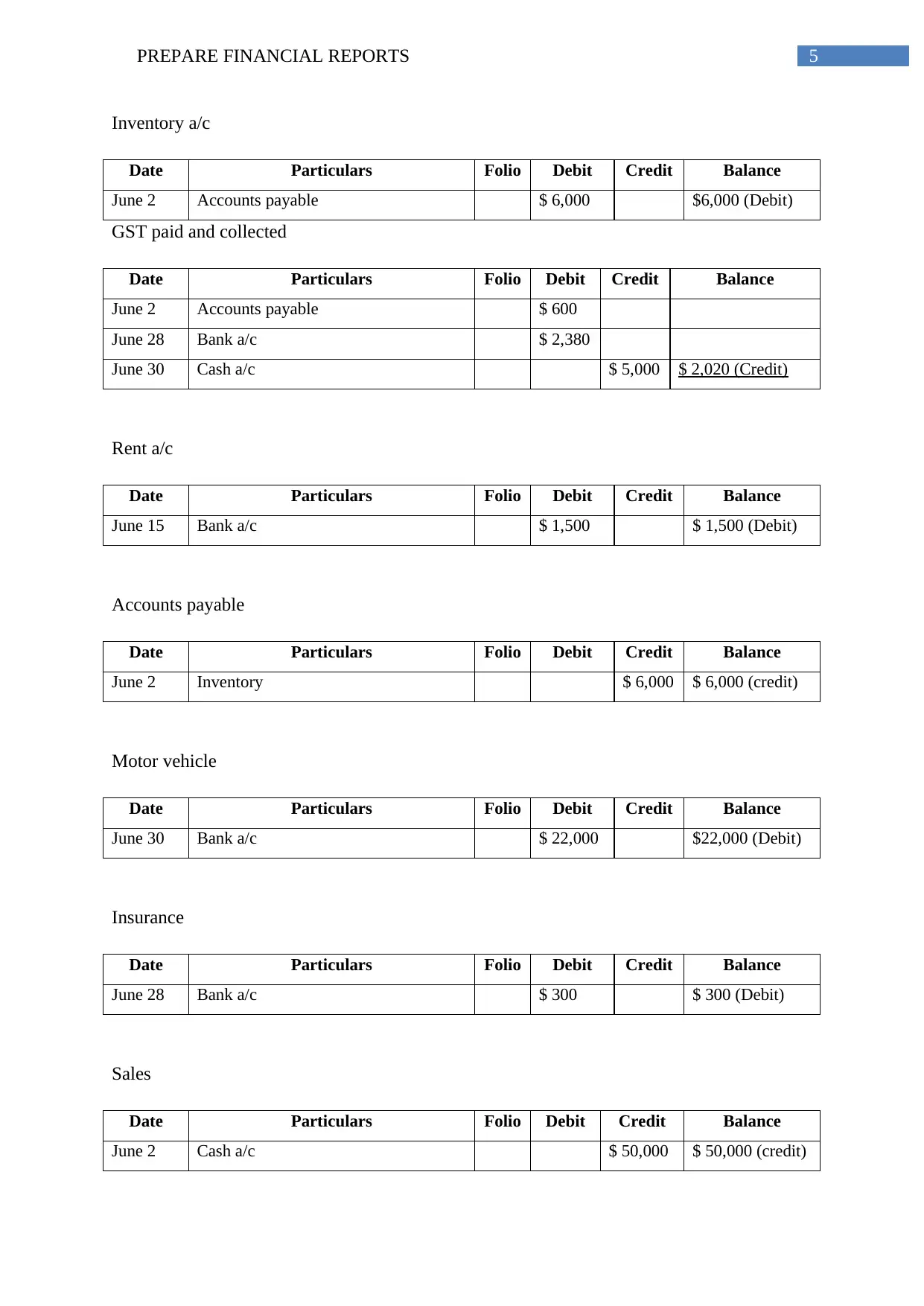
5PREPARE FINANCIAL REPORTS
Inventory a/c
Date Particulars Folio Debit Credit Balance
June 2 Accounts payable $ 6,000 $6,000 (Debit)
GST paid and collected
Date Particulars Folio Debit Credit Balance
June 2 Accounts payable $ 600
June 28 Bank a/c $ 2,380
June 30 Cash a/c $ 5,000 $ 2,020 (Credit)
Rent a/c
Date Particulars Folio Debit Credit Balance
June 15 Bank a/c $ 1,500 $ 1,500 (Debit)
Accounts payable
Date Particulars Folio Debit Credit Balance
June 2 Inventory $ 6,000 $ 6,000 (credit)
Motor vehicle
Date Particulars Folio Debit Credit Balance
June 30 Bank a/c $ 22,000 $22,000 (Debit)
Insurance
Date Particulars Folio Debit Credit Balance
June 28 Bank a/c $ 300 $ 300 (Debit)
Sales
Date Particulars Folio Debit Credit Balance
June 2 Cash a/c $ 50,000 $ 50,000 (credit)
Inventory a/c
Date Particulars Folio Debit Credit Balance
June 2 Accounts payable $ 6,000 $6,000 (Debit)
GST paid and collected
Date Particulars Folio Debit Credit Balance
June 2 Accounts payable $ 600
June 28 Bank a/c $ 2,380
June 30 Cash a/c $ 5,000 $ 2,020 (Credit)
Rent a/c
Date Particulars Folio Debit Credit Balance
June 15 Bank a/c $ 1,500 $ 1,500 (Debit)
Accounts payable
Date Particulars Folio Debit Credit Balance
June 2 Inventory $ 6,000 $ 6,000 (credit)
Motor vehicle
Date Particulars Folio Debit Credit Balance
June 30 Bank a/c $ 22,000 $22,000 (Debit)
Insurance
Date Particulars Folio Debit Credit Balance
June 28 Bank a/c $ 300 $ 300 (Debit)
Sales
Date Particulars Folio Debit Credit Balance
June 2 Cash a/c $ 50,000 $ 50,000 (credit)
⊘ This is a preview!⊘
Do you want full access?
Subscribe today to unlock all pages.

Trusted by 1+ million students worldwide
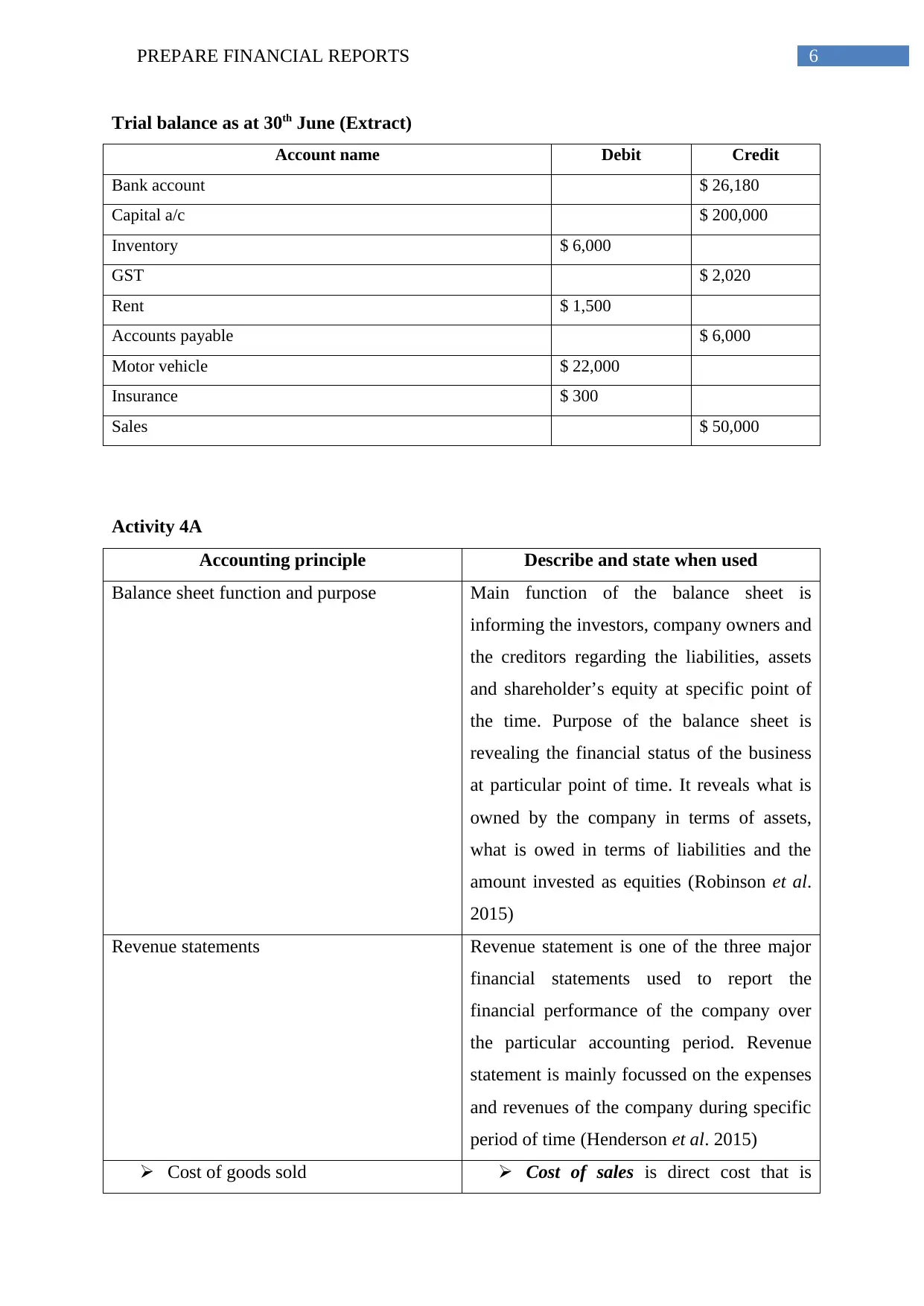
6PREPARE FINANCIAL REPORTS
Trial balance as at 30th June (Extract)
Account name Debit Credit
Bank account $ 26,180
Capital a/c $ 200,000
Inventory $ 6,000
GST $ 2,020
Rent $ 1,500
Accounts payable $ 6,000
Motor vehicle $ 22,000
Insurance $ 300
Sales $ 50,000
Activity 4A
Accounting principle Describe and state when used
Balance sheet function and purpose Main function of the balance sheet is
informing the investors, company owners and
the creditors regarding the liabilities, assets
and shareholder’s equity at specific point of
the time. Purpose of the balance sheet is
revealing the financial status of the business
at particular point of time. It reveals what is
owned by the company in terms of assets,
what is owed in terms of liabilities and the
amount invested as equities (Robinson et al.
2015)
Revenue statements Revenue statement is one of the three major
financial statements used to report the
financial performance of the company over
the particular accounting period. Revenue
statement is mainly focussed on the expenses
and revenues of the company during specific
period of time (Henderson et al. 2015)
Cost of goods sold Cost of sales is direct cost that is
Trial balance as at 30th June (Extract)
Account name Debit Credit
Bank account $ 26,180
Capital a/c $ 200,000
Inventory $ 6,000
GST $ 2,020
Rent $ 1,500
Accounts payable $ 6,000
Motor vehicle $ 22,000
Insurance $ 300
Sales $ 50,000
Activity 4A
Accounting principle Describe and state when used
Balance sheet function and purpose Main function of the balance sheet is
informing the investors, company owners and
the creditors regarding the liabilities, assets
and shareholder’s equity at specific point of
the time. Purpose of the balance sheet is
revealing the financial status of the business
at particular point of time. It reveals what is
owned by the company in terms of assets,
what is owed in terms of liabilities and the
amount invested as equities (Robinson et al.
2015)
Revenue statements Revenue statement is one of the three major
financial statements used to report the
financial performance of the company over
the particular accounting period. Revenue
statement is mainly focussed on the expenses
and revenues of the company during specific
period of time (Henderson et al. 2015)
Cost of goods sold Cost of sales is direct cost that is
Paraphrase This Document
Need a fresh take? Get an instant paraphrase of this document with our AI Paraphraser
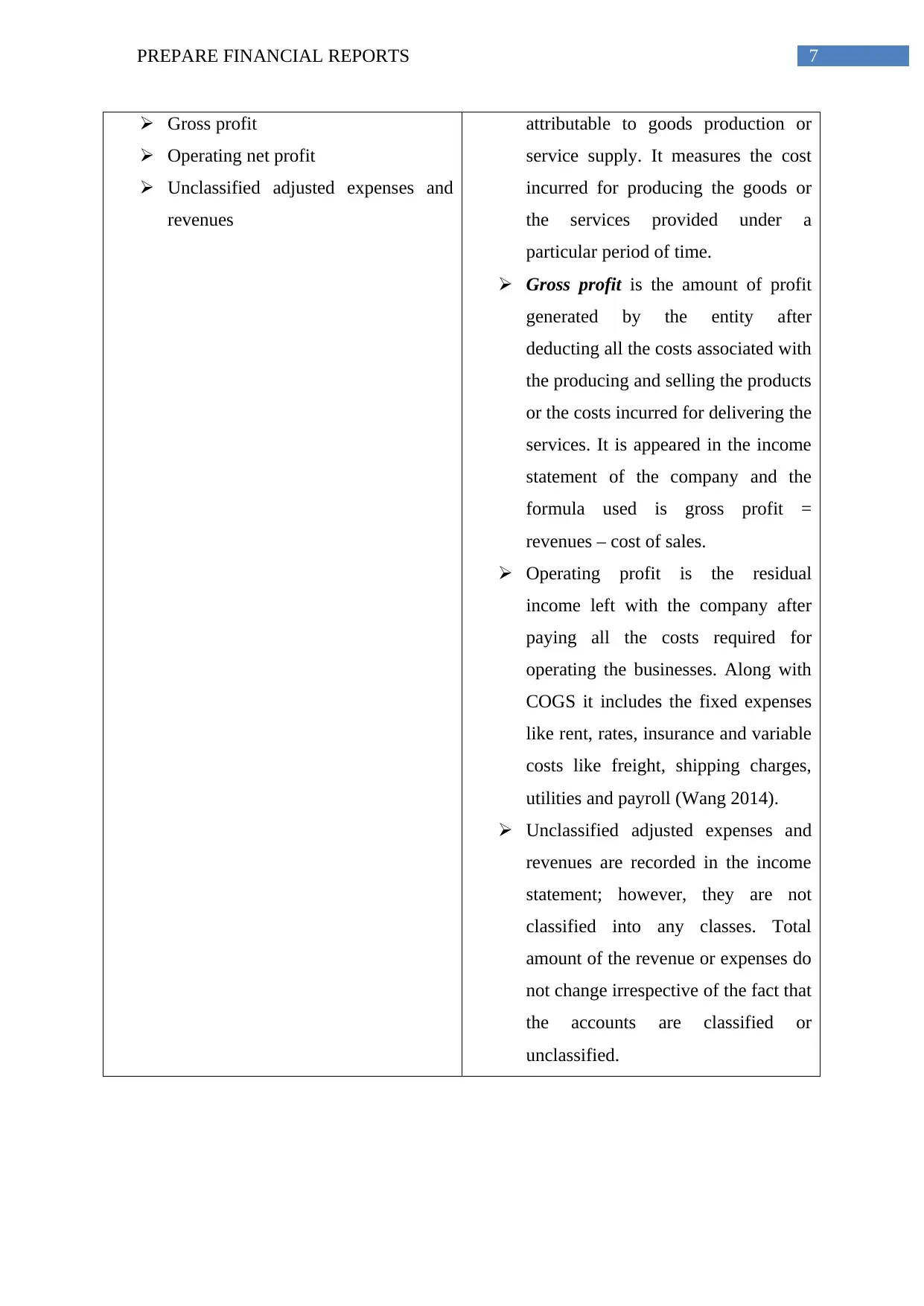
7PREPARE FINANCIAL REPORTS
Gross profit
Operating net profit
Unclassified adjusted expenses and
revenues
attributable to goods production or
service supply. It measures the cost
incurred for producing the goods or
the services provided under a
particular period of time.
Gross profit is the amount of profit
generated by the entity after
deducting all the costs associated with
the producing and selling the products
or the costs incurred for delivering the
services. It is appeared in the income
statement of the company and the
formula used is gross profit =
revenues – cost of sales.
Operating profit is the residual
income left with the company after
paying all the costs required for
operating the businesses. Along with
COGS it includes the fixed expenses
like rent, rates, insurance and variable
costs like freight, shipping charges,
utilities and payroll (Wang 2014).
Unclassified adjusted expenses and
revenues are recorded in the income
statement; however, they are not
classified into any classes. Total
amount of the revenue or expenses do
not change irrespective of the fact that
the accounts are classified or
unclassified.
Gross profit
Operating net profit
Unclassified adjusted expenses and
revenues
attributable to goods production or
service supply. It measures the cost
incurred for producing the goods or
the services provided under a
particular period of time.
Gross profit is the amount of profit
generated by the entity after
deducting all the costs associated with
the producing and selling the products
or the costs incurred for delivering the
services. It is appeared in the income
statement of the company and the
formula used is gross profit =
revenues – cost of sales.
Operating profit is the residual
income left with the company after
paying all the costs required for
operating the businesses. Along with
COGS it includes the fixed expenses
like rent, rates, insurance and variable
costs like freight, shipping charges,
utilities and payroll (Wang 2014).
Unclassified adjusted expenses and
revenues are recorded in the income
statement; however, they are not
classified into any classes. Total
amount of the revenue or expenses do
not change irrespective of the fact that
the accounts are classified or
unclassified.
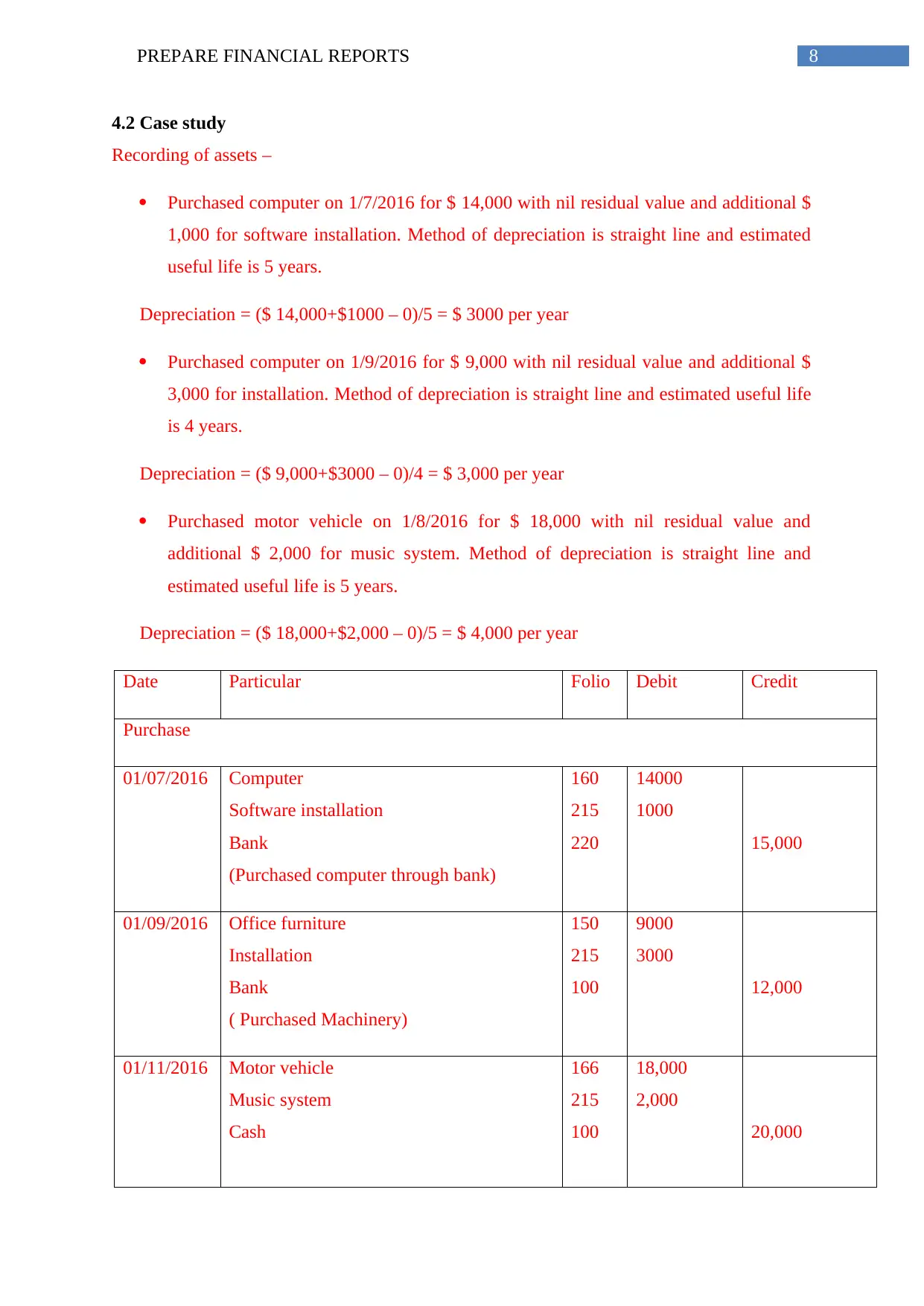
8PREPARE FINANCIAL REPORTS
4.2 Case study
Recording of assets –
Purchased computer on 1/7/2016 for $ 14,000 with nil residual value and additional $
1,000 for software installation. Method of depreciation is straight line and estimated
useful life is 5 years.
Depreciation = ($ 14,000+$1000 – 0)/5 = $ 3000 per year
Purchased computer on 1/9/2016 for $ 9,000 with nil residual value and additional $
3,000 for installation. Method of depreciation is straight line and estimated useful life
is 4 years.
Depreciation = ($ 9,000+$3000 – 0)/4 = $ 3,000 per year
Purchased motor vehicle on 1/8/2016 for $ 18,000 with nil residual value and
additional $ 2,000 for music system. Method of depreciation is straight line and
estimated useful life is 5 years.
Depreciation = ($ 18,000+$2,000 – 0)/5 = $ 4,000 per year
Date Particular Folio Debit Credit
Purchase
01/07/2016 Computer
Software installation
Bank
(Purchased computer through bank)
160
215
220
14000
1000
15,000
01/09/2016 Office furniture
Installation
Bank
( Purchased Machinery)
150
215
100
9000
3000
12,000
01/11/2016 Motor vehicle
Music system
Cash
166
215
100
18,000
2,000
20,000
4.2 Case study
Recording of assets –
Purchased computer on 1/7/2016 for $ 14,000 with nil residual value and additional $
1,000 for software installation. Method of depreciation is straight line and estimated
useful life is 5 years.
Depreciation = ($ 14,000+$1000 – 0)/5 = $ 3000 per year
Purchased computer on 1/9/2016 for $ 9,000 with nil residual value and additional $
3,000 for installation. Method of depreciation is straight line and estimated useful life
is 4 years.
Depreciation = ($ 9,000+$3000 – 0)/4 = $ 3,000 per year
Purchased motor vehicle on 1/8/2016 for $ 18,000 with nil residual value and
additional $ 2,000 for music system. Method of depreciation is straight line and
estimated useful life is 5 years.
Depreciation = ($ 18,000+$2,000 – 0)/5 = $ 4,000 per year
Date Particular Folio Debit Credit
Purchase
01/07/2016 Computer
Software installation
Bank
(Purchased computer through bank)
160
215
220
14000
1000
15,000
01/09/2016 Office furniture
Installation
Bank
( Purchased Machinery)
150
215
100
9000
3000
12,000
01/11/2016 Motor vehicle
Music system
Cash
166
215
100
18,000
2,000
20,000
⊘ This is a preview!⊘
Do you want full access?
Subscribe today to unlock all pages.

Trusted by 1+ million students worldwide
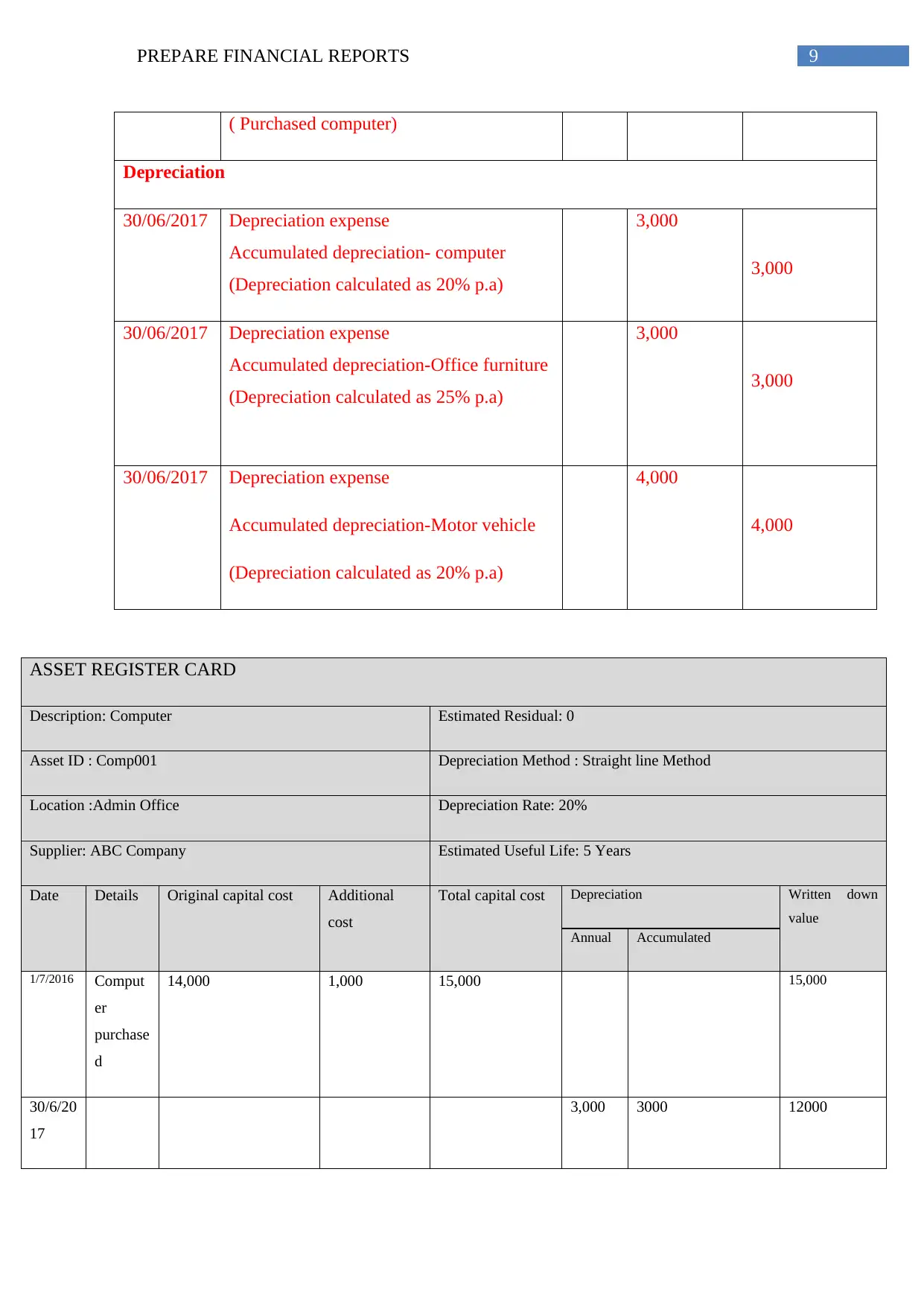
9PREPARE FINANCIAL REPORTS
( Purchased computer)
Depreciation
30/06/2017 Depreciation expense
Accumulated depreciation- computer
(Depreciation calculated as 20% p.a)
3,000
3,000
30/06/2017 Depreciation expense
Accumulated depreciation-Office furniture
(Depreciation calculated as 25% p.a)
3,000
3,000
30/06/2017 Depreciation expense
Accumulated depreciation-Motor vehicle
(Depreciation calculated as 20% p.a)
4,000
4,000
ASSET REGISTER CARD
Description: Computer Estimated Residual: 0
Asset ID : Comp001 Depreciation Method : Straight line Method
Location :Admin Office Depreciation Rate: 20%
Supplier: ABC Company Estimated Useful Life: 5 Years
Date Details Original capital cost Additional
cost
Total capital cost Depreciation Written down
value
Annual Accumulated
1/7/2016 Comput
er
purchase
d
14,000 1,000 15,000 15,000
30/6/20
17
3,000 3000 12000
( Purchased computer)
Depreciation
30/06/2017 Depreciation expense
Accumulated depreciation- computer
(Depreciation calculated as 20% p.a)
3,000
3,000
30/06/2017 Depreciation expense
Accumulated depreciation-Office furniture
(Depreciation calculated as 25% p.a)
3,000
3,000
30/06/2017 Depreciation expense
Accumulated depreciation-Motor vehicle
(Depreciation calculated as 20% p.a)
4,000
4,000
ASSET REGISTER CARD
Description: Computer Estimated Residual: 0
Asset ID : Comp001 Depreciation Method : Straight line Method
Location :Admin Office Depreciation Rate: 20%
Supplier: ABC Company Estimated Useful Life: 5 Years
Date Details Original capital cost Additional
cost
Total capital cost Depreciation Written down
value
Annual Accumulated
1/7/2016 Comput
er
purchase
d
14,000 1,000 15,000 15,000
30/6/20
17
3,000 3000 12000
Paraphrase This Document
Need a fresh take? Get an instant paraphrase of this document with our AI Paraphraser
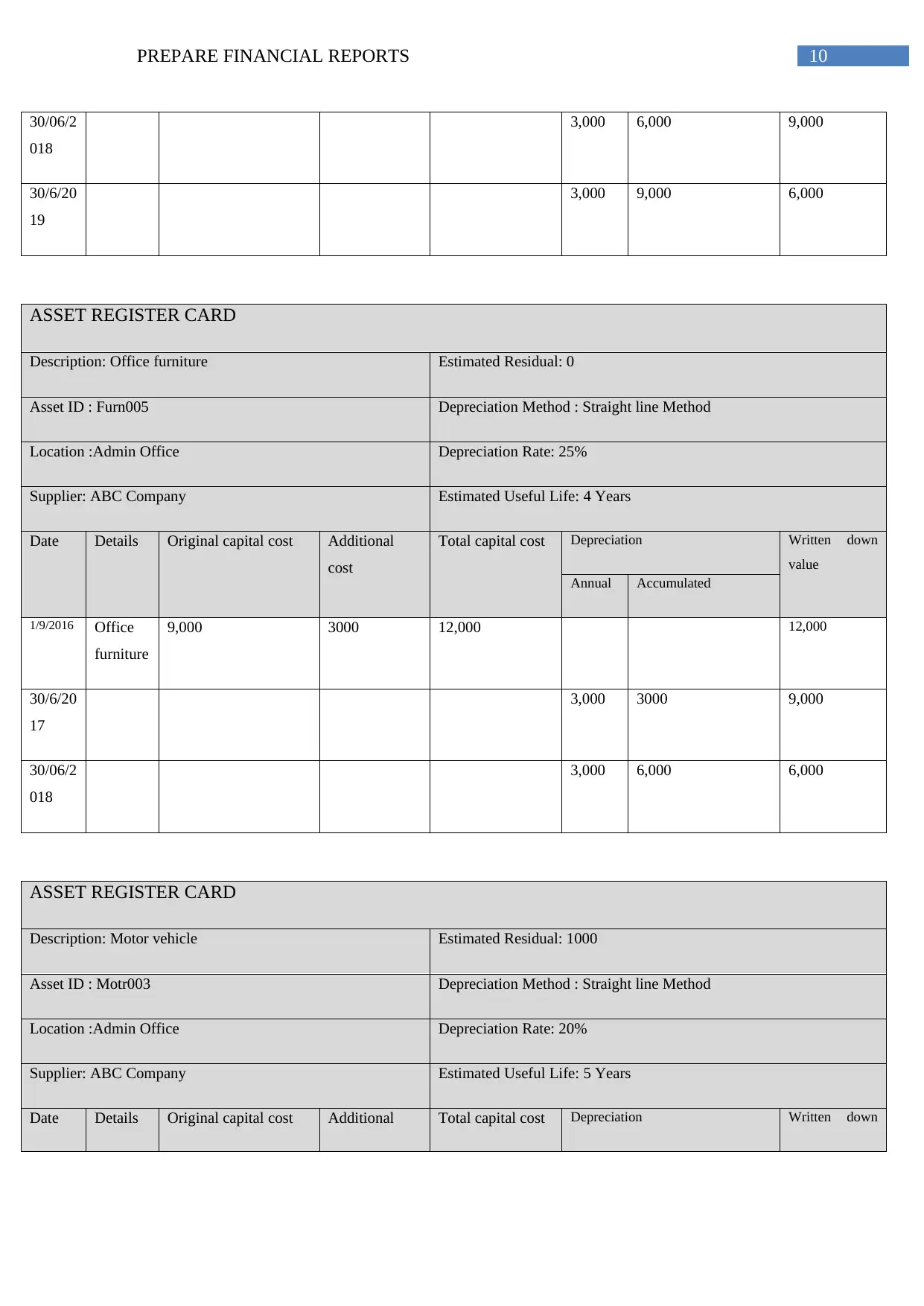
10PREPARE FINANCIAL REPORTS
30/06/2
018
3,000 6,000 9,000
30/6/20
19
3,000 9,000 6,000
ASSET REGISTER CARD
Description: Office furniture Estimated Residual: 0
Asset ID : Furn005 Depreciation Method : Straight line Method
Location :Admin Office Depreciation Rate: 25%
Supplier: ABC Company Estimated Useful Life: 4 Years
Date Details Original capital cost Additional
cost
Total capital cost Depreciation Written down
value
Annual Accumulated
1/9/2016 Office
furniture
9,000 3000 12,000 12,000
30/6/20
17
3,000 3000 9,000
30/06/2
018
3,000 6,000 6,000
ASSET REGISTER CARD
Description: Motor vehicle Estimated Residual: 1000
Asset ID : Motr003 Depreciation Method : Straight line Method
Location :Admin Office Depreciation Rate: 20%
Supplier: ABC Company Estimated Useful Life: 5 Years
Date Details Original capital cost Additional Total capital cost Depreciation Written down
30/06/2
018
3,000 6,000 9,000
30/6/20
19
3,000 9,000 6,000
ASSET REGISTER CARD
Description: Office furniture Estimated Residual: 0
Asset ID : Furn005 Depreciation Method : Straight line Method
Location :Admin Office Depreciation Rate: 25%
Supplier: ABC Company Estimated Useful Life: 4 Years
Date Details Original capital cost Additional
cost
Total capital cost Depreciation Written down
value
Annual Accumulated
1/9/2016 Office
furniture
9,000 3000 12,000 12,000
30/6/20
17
3,000 3000 9,000
30/06/2
018
3,000 6,000 6,000
ASSET REGISTER CARD
Description: Motor vehicle Estimated Residual: 1000
Asset ID : Motr003 Depreciation Method : Straight line Method
Location :Admin Office Depreciation Rate: 20%
Supplier: ABC Company Estimated Useful Life: 5 Years
Date Details Original capital cost Additional Total capital cost Depreciation Written down
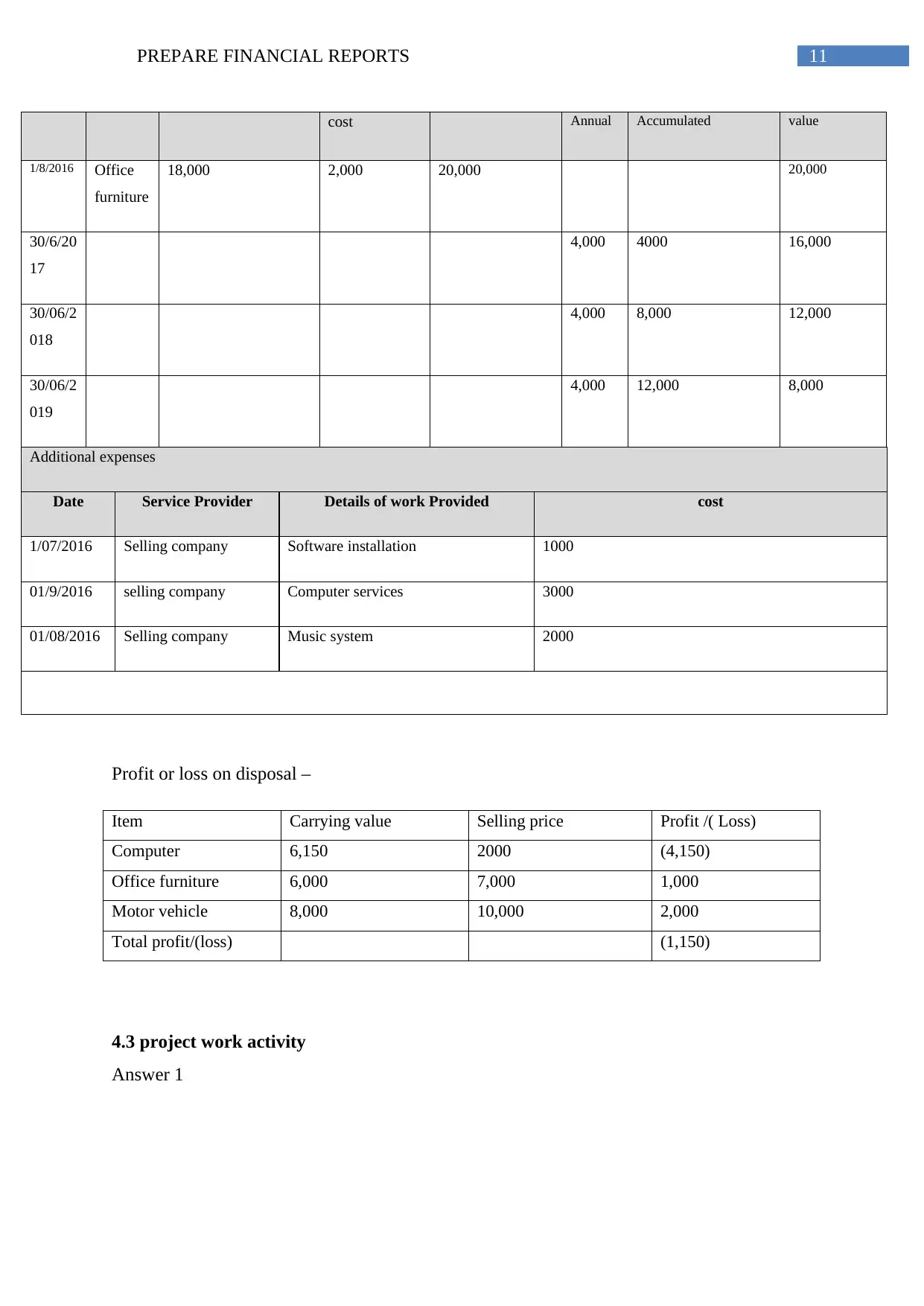
11PREPARE FINANCIAL REPORTS
cost valueAnnual Accumulated
1/8/2016 Office
furniture
18,000 2,000 20,000 20,000
30/6/20
17
4,000 4000 16,000
30/06/2
018
4,000 8,000 12,000
30/06/2
019
4,000 12,000 8,000
Additional expenses
Date Service Provider Details of work Provided cost
1/07/2016 Selling company Software installation 1000
01/9/2016 selling company Computer services 3000
01/08/2016 Selling company Music system 2000
Profit or loss on disposal –
Item Carrying value Selling price Profit /( Loss)
Computer 6,150 2000 (4,150)
Office furniture 6,000 7,000 1,000
Motor vehicle 8,000 10,000 2,000
Total profit/(loss) (1,150)
4.3 project work activity
Answer 1
cost valueAnnual Accumulated
1/8/2016 Office
furniture
18,000 2,000 20,000 20,000
30/6/20
17
4,000 4000 16,000
30/06/2
018
4,000 8,000 12,000
30/06/2
019
4,000 12,000 8,000
Additional expenses
Date Service Provider Details of work Provided cost
1/07/2016 Selling company Software installation 1000
01/9/2016 selling company Computer services 3000
01/08/2016 Selling company Music system 2000
Profit or loss on disposal –
Item Carrying value Selling price Profit /( Loss)
Computer 6,150 2000 (4,150)
Office furniture 6,000 7,000 1,000
Motor vehicle 8,000 10,000 2,000
Total profit/(loss) (1,150)
4.3 project work activity
Answer 1
⊘ This is a preview!⊘
Do you want full access?
Subscribe today to unlock all pages.

Trusted by 1+ million students worldwide
1 out of 17
Related Documents
Your All-in-One AI-Powered Toolkit for Academic Success.
+13062052269
info@desklib.com
Available 24*7 on WhatsApp / Email
![[object Object]](/_next/static/media/star-bottom.7253800d.svg)
Unlock your academic potential
Copyright © 2020–2025 A2Z Services. All Rights Reserved. Developed and managed by ZUCOL.




